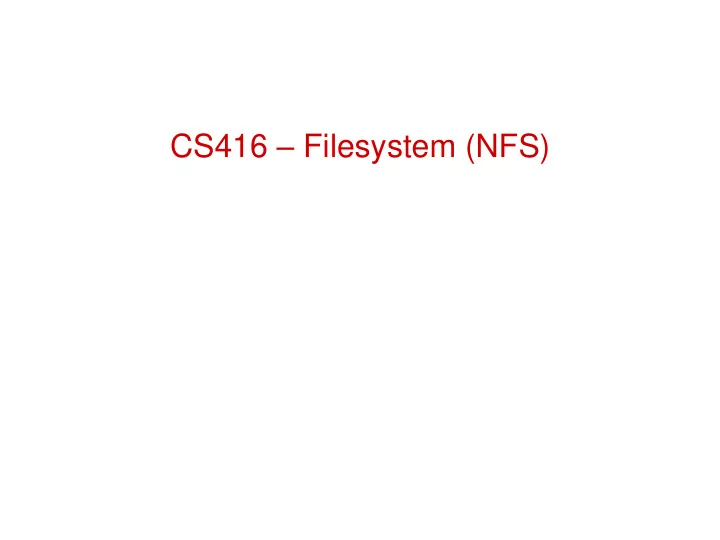

CS416 – Filesystem (NFS)
NFS NFS allows a system to access files over a network • One of many distributed file systems • Extremely successful and widely used
NFS Challenges Development of LANs made it really attractive to provide shared file systems to all machines on a network • Login to any machine and see the same set of files • Install software on a single server that all machines can run • Let users collaborate on shared set of files (before CVS!) Why might this be hard to do??? • Clients and servers might be running different OS • Clients and servers might be using different CPU architecture with differing byte ordering ( endianess ) • Client or server might crash independently of each other • Must be easy to recover from crashes • Potentially very large number of client machines on a network • Different users might be trying to modify a shared file at the same time • Transparency: Allow user programs to access remote files just like local files • No special libraries, recompilation, etc.
Three Independent File Systems
NFS Overview
NFS Design
Stateless Protocol
Stateless Protocol
NFS Protocol Overview
Example
Example -2 What happens if we issue • fd = open(“/ usr/joe/6360/list.txt ”) It would result it several Lookup calls to server • lookup(rootfh , “ usr ”) returns (fh0, attr) • lookup(fh0, “ joe ”) returns (fh1, attr) • lookup(fh1, “6360”) returns (fh2, attr) • lookup(fh2, “list.txt”) returns ( fh, attr) Why is this needed ? • Any of components of /usr/joe/6360/list.txt could be a mount point • Mount points are client dependent and mount information is kept above the lookup() level
NFS Caching
NFS Locking
NLM Protocol
NLM Example
NLM Example
NLM Example
NLM Example
Three Major Layers of NFS Architecture UNIX file-system interface (based on the open, read, write , and close calls, and file descriptors ) Virtual File System (VFS) layer – distinguishes local files from remote ones, and local files are further distinguished according to their file-system types • The VFS activates file-system-specific operations to handle local requests according to their file-system types • Calls the NFS protocol procedures for remote requests NFS service layer – bottom layer of the architecture • Implements the NFS protocol
Schematic View of NFS Architecture
Recommend
More recommend